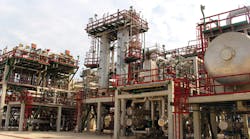A study conducted for the Occupational Safety and Health Administration doesn't come down firmly on any side of the issue of whether increased use of contract workers poses a threat to the safety record of hydrocarbon processing plants.
John Gray Institute, Lamar University System, Beaumont, Tex., studied safety and health practices in U.S. refineries and petrochemical plants under a contract with OSHA.
Safety issues in both industries will be the focus of an OSHA sponsored conference of plant executives, safety specialists, and labor officials scheduled tentatively for December in Washington, D.C. OSHA will release the final report based on the John Gray study in October.
The preliminary report is based on nine case studies and a nationwide survey of process plant managers. It presents no final conclusions or policy recommendations but illustrates the approach, data collected, and preliminary observations of the work in progress.
At recommendation of the study's steering committee, the survey of plant managers is being expanded by surveys of contractor company managers, union/nonunion, and permanent/contractor workers.
SURVEY OF MANAGERS
The survey of process plant managers sought to determine whether plant practices are adequate to protect safety and health of all workers and as extensive and effective for contract workers as for permanent ones.
Questionnaires were received from 256 companies in five Office of Management and Budget standard industrial categories (SICs), representing a universe of 4,000 plants employing 426,510 workers. Based on those responses, John Gray determined:
- Work deferred to contractors has increased in all areas surveyed. But while reliance on contractors has increased, data suggest it is because of industry expansion rather than substitution for permanent employees.
- Use of contract employees mainly has increased in traditional contractor activities. Plant managers mainly cite flexibility, cost, specialty in asbestos removal, and capital expansion in increased contractor work.
- While 25% of respondents didn't know the number of fatalities among contract employees working in their plants, only 1.4% didn't know that number among permanent employees.
- Fatalities per million man-hours decline as total hours worked increase but at the same rate for contract and permanent employees alike.
- Although accident rates overall tend to increase with increased hours worked and plant size, as contract employees work more hours their injury rates fall.
- The most commonly used method of monitoring contractor safety-requiring reports of all accidents-suggests a reactive vs. preventive posture among plant managers.
CASE STUDIES
Selected for case studies were three plastics plants, one synthetic rubber plant, three organic chemical plants, and two refineries. More than one plant crossed several SIC categories.
Two plants in the study group are part of corporations regarded as having model safety and health programs, four were cited as "problematic" by the steering committee, and three are foreign owned.
Some findings about plants in the study group mirrored trends seen in the survey, but others did not, including:
- Plant managers said reliance on contract workers has increased, mainly for routine and nonroutine maintenance.
- Cost control was the overriding reason cited for increased use of contract labor, mostly related to lower wages without employee benefits and flexibility to use labor only when needed.
- Standards guiding contractor selection are established at the plant level and vary widely in the study group. Two plants had no safety criteria, and while some plants reported rigorous screening procedures, some routinely deviated from their established criteria.
- Seven plants either didn't track contractor safety performance or appeared to pay little attention to it. However, two plants had recently hired new long term maintenance contractors due to poor safety performance of the previous contractor.
- In cases where data were available, short term and long term contract workers alike had higher illness/injury rates than permanent plant employees.
- While partly motivated by safety considerations, routine segregation of contract employees appears to cause communication problems that circumvent safety procedures, creating potential hazards. In all but one unionized plant, relationships between contract and permanent employees were openly hostile.
- Permanent employees and contract employees show marked differences in awareness of process safety, safety procedures, and emergency response.
- Language barriers among contract workers were cited as a problem in four of the five West Coast and Gulf Coast plants studied.
MODEL PLANT
Management of one plant in the study group had virtually eliminated distinctions between safety and health practices of contract and permanent employees. Even within its own corporation, the study found, it is considered an anomaly.
Management's main goal at the model plant is to achieve long term continuity, assuming greater familiarity with the plant will result in improved safety and efficiency. Product quality, productivity, and profitability are exceptional at the plant.
To work there, contractors must meet rigorous prebid safety requirements, including comprehensive safety training and employee benefit packages. Contract employee wages are commensurate with those of permanent employees.
Upon entering the plant, contract employees are trained and often supervised by special personnel and continue to receive safety training. The main contract employees and permanent workers at this plant reported the lowest OSHA illness/injury rates in the study group.
High levels of contract and permanent employee satisfaction and loyalty were reported at the model plant-to the extent several contract workers left a former contractor at the plant in order to continue working there. Nearly 90% of the contract employees have worked at the plant since its construction.
Copyright 1990 Oil & Gas Journal. All Rights Reserved.
